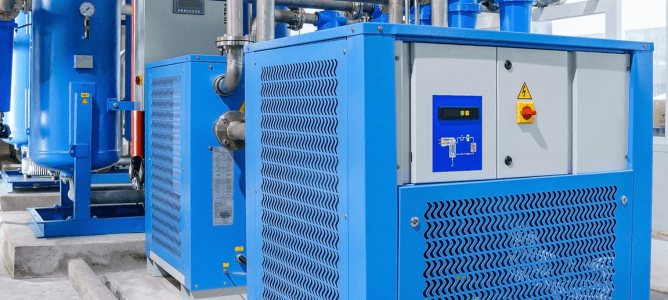
Understanding Air Compressor Inlets
Air compressor inlets play a critical role in determining the overall performance of compressed air systems. These inlets, where air enters the system, set the foundation for the entire compression process.
In this article, we’ll explore the function of air compressor inlets, the factors that influence their performance, and best practices for maintaining their efficiency in industrial and commercial systems.
The Role of Air Compressor Inlets
The inlet is the starting point for all compressed air systems. It draws in atmospheric air, which is then compressed to the required pressure for industrial applications. The quality, temperature, and volume of air entering through the inlet directly affect the compressor’s efficiency and the quality of the compressed air delivered.
Why Air Compressor Inlet Optimization Matters
Optimizing your air compressor’s inlet can lead to:
- Reduced energy costs due to improved efficiency.
- Longer compressor lifespan by preventing wear from contaminants.
- Better air quality for downstream applications.
Factors That Can Affect Air Compressor Inlet Performance
1. Air Quality
The quality of air entering the inlet directly impacts the efficiency and longevity of a compressed air system. Contaminants like dust, dirt, oil, and moisture can:
- Cause internal wear and tear on compressor components, leading to costly repairs.
- Reduce overall system efficiency by clogging filters or settling in piping and storage tanks.
- Compromise the purity of the compressed air, which can be critical for applications in food processing, pharmaceuticals, or electronics manufacturing.
Solution: Installing high-efficiency inlet filters with the correct particle size rating can trap contaminants before they enter the system. Regular filter maintenance or replacement is equally important to ensure long-term effectiveness.
2. Temperature of Inlet Air
Compressed air systems perform optimally with cooler inlet air. Cooler air is denser, meaning the system can compress more air volume per cycle, which translates to higher efficiency. However, excessive heat near the inlet can lead to:
- Higher energy consumption, as the compressor must work harder to achieve the desired pressure.
- Reduced system performance over time, as heat increases strain on internal components.
3. Inlet Pressure
Inlet pressure loss occurs when resistance or restrictions develop in the pathway to the compressor. Common causes include blocked or poorly maintained inlet filters, as well as undersized piping or improperly designed inlet ducts. These restrictions create pressure drops, forcing the compressor to work harder to draw in air. This increased effort leads to higher energy consumption and can create bottlenecks that hinder system performance.
To minimize pressure losses, it’s crucial to ensure that inlet piping and ductwork are appropriately sized to meet the system’s airflow requirements. Regular inspection and cleaning of ducts, filters, and other components also help maintain unrestricted airflow and optimize system efficiency.
4. Proximity to Contaminant Sources
Locating the inlet too close to industrial exhaust systems, chemical storage areas, or other sources of pollution can introduce harmful particles or vapors into the compressor. This can lead to:
- Contamination of the compressed air, which may affect sensitive downstream equipment or processes.
- Corrosion and premature wear of compressor internals due to exposure to acidic or reactive particles.
For example, if the inlet is located near a paint booth, it could draw in overspray particles, clogging filters and compromising the compressed air system.
Best practices for placement:
- Install the inlet in a clean, uncontaminated area with stable ambient conditions.
- If relocating is not possible, consider using advanced filtration systems or air intakes with pre-separators to capture contaminants.
Maintenance Tips for Air Compressor Inlets
- Regular cleaning. Periodically clean the inlet filters to prevent clogging and maintain unrestricted airflow.
- Filter replacements. Replace filters as needed to avoid bypass and ensure consistent air quality.
- Monitor for leaks. Check for leaks or loose connections around the inlet that could introduce unfiltered air.
- Optimize placement. Ensure the inlet is positioned away from high-heat, high-dust, or chemical-laden environments.
Common Misconceptions About Air Compressor Inlets
- “Any filter will do.” Not all filters are equal; select a filter rated for your compressor’s specifications and application to achieve the best results.
- “Inlet location doesn’t matter.” The placement of your inlet can significantly impact air quality and system efficiency. Always consider environmental factors when positioning the inlet.
- “Maintenance can be skipped if the system is running fine.” Neglecting air compressor maintenance can lead to long-term damage, reduced efficiency, and costly repairs.
Need Expert Advice On Optimizing Your Compressed Air System?
NiGen specializes in industrial air solutions, including maintenance, system design, and consulting services. Contact us today to learn how we can help you improve your air compression processes.
